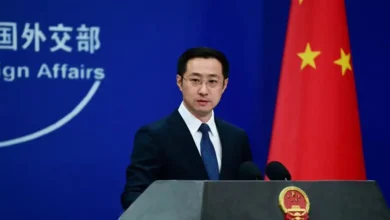
NexNews — China has escalated its military activity around Taiwan, deploying several formations of naval and coast guard vessels in the Taiwan Strait and Western Pacific. Taiwan’s Defense Ministry confirmed on Monday that it had identified Chinese People’s Liberation Army (PLA) vessels from multiple theaters, including the Eastern, Northern, and Southern commands, as well as Coast Guard ships entering the area. This military maneuver follows Taiwan President Lai Ching-te’s recent controversial trip to Hawaii and Guam during a diplomatic tour to the South Pacific, which has intensified tensions with Beijing.
Lai’s visits, which Beijing vehemently opposed, were seen as provocative actions by China, which views Taiwan as a breakaway province. The Chinese government denounced Lai’s trip, referring to him as a “separatist” and labeling the visits a violation of China’s sovereignty. In response to these developments, Beijing had also condemned the recent approval of U.S. arms sales to Taiwan, warning of “strong countermeasures.”
Taiwan’s leadership has consistently rejected China’s territorial claims, reinforcing its sovereignty and independence. Beijing, on the other hand, has vowed to “reunify” with Taiwan, including by force if necessary. As tensions mount, Taiwan’s Defense Ministry confirmed that it has started combat readiness exercises to prepare for any potential military actions from China. Taiwan remains on high alert, closely monitoring the movements of Chinese military forces.
A senior Taiwanese official described China’s current naval deployment as larger than previous military drills this year, including those in May and October, which were termed “punishments” by China for Taiwan’s political actions. These drills involved encircling Taiwan with military assets, but China’s latest naval movements suggest a different strategic focus. Chinese naval ships appear to be positioning themselves to assert control within the First Island Chain, a strategically significant zone that includes Taiwan, Japan, and the Philippines.
In addition, China has reserved seven airspace zones to the east of its coastal provinces, which lie north and northwest of Taiwan. While other aircraft can still pass through with permission, these zones have been set aside for specific military use, further escalating the situation.
Despite Beijing’s aggressive stance, Taiwan’s President Lai, during his visit to Guam, called for deeper solidarity among democracies, urging all people to defend their democratic values against authoritarianism. His remarks came as Beijing condemned his actions and warned that it would take “resolute and strong measures” to protect its territorial integrity.
As China intensifies its military activities and rhetoric, Taiwan remains vigilant, bolstering its defenses in anticipation of potential provocations.





